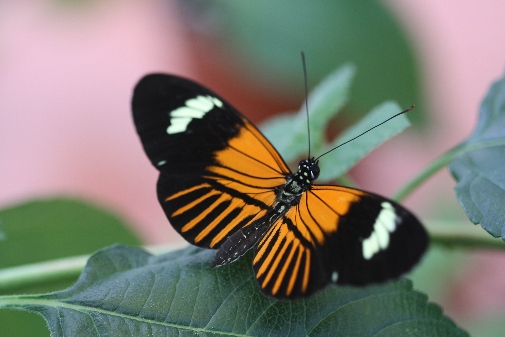Researchers have shown that an Amazonian butterfly is a hybrid species, formed by two other species breeding together almost 200,000 years ago.
 Hybridisation drove the evolution of Heliconius elevatus.
Hybridisation drove the evolution of Heliconius elevatus.
The discovery, by an international team led by scientists at the University of York and Harvard University, demonstrates how the formation of new species can be more complex than previously imagined.
Species are often thought of as the tips, or leaves in a 'tree of life'. In this model, new species are produced by the tips splitting to form new species over thousands to millions of years.
Scientists now understand, however, that the branches in the tree of life are tangled, with genes being transferred from one species to another by occasional interbreeding. This can theoretically result in the formation of a new species; a process known as hybrid speciation.
Decade-long study
However, proving hybrid speciation is possible in animals is a difficult task, as scientists need to demonstrate that breeding between two species actually triggered the formation of an entirely new species that is genetically distinct from both parents.
The team of scientists, which includes researchers from a number of South American countries, have now found an example of a hybrid species among the brightly coloured Heliconius butterflies of the Amazon.
In a decade-long study, the researchers accumulated genetic and ecological evidence demonstrating that almost 200,000 years ago, the ancestor of today's Heliconius melpomene and Heliconius pardalinus contributed parts of their genomes to produce a distinct third species, Heliconius elevatus, and that all three species now co-exist in the Amazon rainforest.
Genetic basis
Professor Kanchon Dasmahapatra, from the University of York's Department of Biology, and senior author of the study said: "Hybrid speciation may not be that uncommon, but convincing examples of animal hybrid species are really difficult to come by.
"In the few examples that exist, either the supposed hybrid species have only existed for a few generations and may be short-lived entities, or the hybrid species does not live alongside its parental species, making it difficult to know whether it is actually a new species."
Lead author Dr Neil Rosser, postdoctoral researcher at the University of York and now at Harvard University, spent several years in the Amazon crossing the species involved to uncover the genetic basis of multiple traits that are important for maintaining a species' distinctiveness. These traits included colour pattern, wing shape, host plant preference, sex pheromones, mate choice and flight.
Unique combination
Dr Rosser said: "Remarkably, we found that in Heliconius elevatus, the parts of the genome controlling these important traits are often derived from Heliconius melpomene.
"This finding is key to demonstrating that hybridisation drove the evolution of Heliconius elevatus, because it endowed the species with a unique combination of traits that prevent it from interbreeding with either of its parents."
Professor Dasmahapatra added: "With species' distributions changing rapidly due to human actions and climate change, opportunities for hybridisation or mixing between species are likely to increase, which has important implications.
"This increased mixing will likely cause more genes to move among species, in some cases leading to species being swamped by other species' genes, and in other cases possibly to the formation of new hybrid species in the future."











